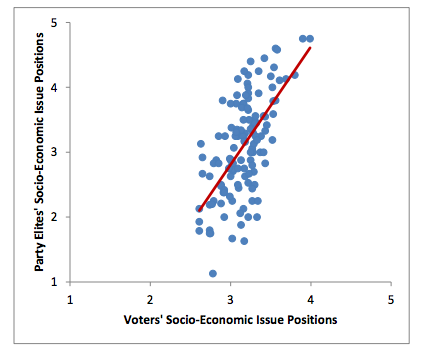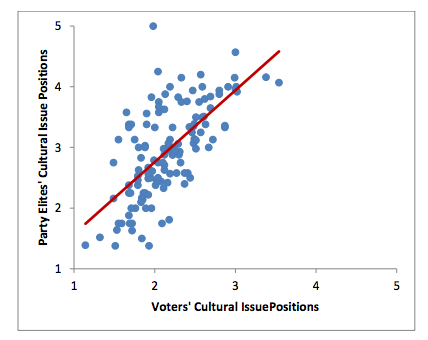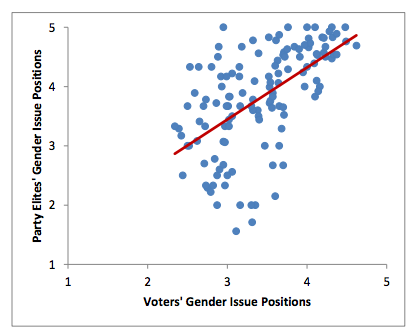Political parties do represent their voters, but the degree of representation varies across issues and parties
Politicians are frequently castigated as being ‘out of touch with voters’, with populist movements of both the left and the right prospering in recent years at least in part due to this perception. But how valid is it? Russell Dalton looks at European political parties and in his study found that, on the whole, political parties do a decent job of representing the views of their constituents across a range of issues, even during times of acute crisis.
Did Gordon Brown represent Labour voters? (Credit: Monika Flueckiger, CC BY SA 2.0)
Europeans’ decreasing trust in government and political institutions over the past two decades has stimulated a chorus of experts claiming that a crisis of democratic representation exists today, fuelling public distrust. Political elites are presumably unresponsive to the public, and governments have become inefficient and sclerotic. In the Economist’s Year in 2015 issue, the editor began by stating: “Of all the predictions to be made about 2015, none seems safer than the idea that across the great democracies people will feel deeply let down by those who lead them.”
My recent study, “Party Representation across Multiple Issue Dimensions,” examines a key feature of this debate—do political party elites effectively represent their voters.
Policy agreement between voters and their preferred party is a central measure of the functioning of representative democracy. In fact, most of the academic literature on representation consistently demonstrates high levels of Left-Right agreement between voters and the positions of their respective parties. These results produce optimistic evaluations of the functioning of representative democracy.
My study presses beyond prior research in two ways. First, instead of looking at broad Left-Right agreement, I examine voters’ agreement with the candidates of their chosen party in more specific policy areas. Voters and candidates were asked identical questions about their issue positions. Second, I examine evidence from the 2009 European Parliament election, which provides a robust test of representative democracy as parties and governments were being severely challenged by Europe’s developing financial crisis. Within the 27 EU member states, there are about 130 parties for which the voter and candidate surveys had a sufficient number of respondents for analysis.
The results provide valuable insights into party politics across Europe. For example, party systems have long been structured around the socio-economic issues of government intervention in the economy, the role of private enterprise, and income inequality. European party elites remain deeply divided on these issues, but not so party voters (figure 1). An index combing three survey questions shows that party voter groups cluster around a centrist position on these matters (on the horizontal axis)—but party leaders remain highly divided (on the vertical axis). To a degree, political parties over-polarize their voters’ opinions on these issues. Think of Jeremy Corbyn and his current Labour Party as one example on the Left, or the Dutch VVD as an example on the right.
Figure 1. Comparing Voters and Party Elite on Socio-Economic Policy
Note: Each dot represents a party dyad. The horizontal axis plots the mean score of each party’s voters; the vertical axis plots the mean score of the party’s EP candidates.
A second issue area concerns the cultural conflicts that currently divide European publics: immigration, harsher penalties for criminals, and a stress on authority in education. This dimension is similar to what some scholars describe as the syndrome of traditional, authoritarian, and nationalist (TAN) orientations.
The distribution of party voters is spread out on this issue, as are party elites (Figure 2). The spread in voters’ issue positions is almost double those for the socio-economic issue index. Party elites are very responsive to their voters on the culture index, and there is an even stronger correlation between dyad pairs than for socio-economic issues.
Figure 2. Comparing Voters and Party Elite on Cultural Policy
The final comparison includes three gender items of abortion rights, equal pay, and same sex marriages. Perhaps not surprisingly, the representation linkage is weakest for this issue area. Opinions are relatively diverse among party voters, but party elites are not highly responsive to their respective constituencies, and parties are widely dispersed so that the correlation between the party dyads is the weakest of these three examples. These are often issues with strong opinions by both voters and party elites, but they are also issues that where the positions of party elites seem less responsive the voters’ preferences.
Figure 3. Comparing Voters and Party Elite on Gender Policy
The rest of my study examines the factors that affect issue representation. And three points bear repeating here. First, a party’s success in representing its voters in one policy area is virtually unrelated to its performance in the two other areas. This may explain some of voters’ frustration with party politics; for a growing number of people there is no party that best represents their positions on most of the salient issues. Second, most national and party-level traits are not strongly and consistently related to the parties’ policy representation—which is a good thing because it means that democratic representation is not closely bound to specific institutional arrangements or types of political parties. Third, there is some evidence that parties with extreme issue positions are less congruent with their supporters than centrist parties. These parties are often are selling an ideology, rather than selling what the political market wants, and this may diminish their sensitivities to their voters’ preferences.
In summary, each election presents new issue choices for the voters as their own or the parties’ policy positions change in reaction to events. I took a snapshot of this process in the 2009 European Parliament election. Political parties as a whole generally do a reasonable job in representing their voters—even in the midst of the 2009 financial crisis—but the degree of representation varies substantially across issue areas and political parties. Even given the caveats discussed above, the evidence speaks to the overall ability of like-minded voters and parties to connect at election time. The connection is imperfect, as is inevitable, but the generally high level of congruence speaks against those who claim that democratic representation is failing.
—
Note: this post represents the views of the author and not those of Democratic Audit UK or the LSE. Please read our comments policy before posting.
—
 Russell Dalton is Professor of Social Science at the University of California, Irvine (UCI)
Russell Dalton is Professor of Social Science at the University of California, Irvine (UCI)









 Democratic Audit's core funding is provided by the Joseph Rowntree Charitable Trust. Additional funding is provided by the London School of Economics.
Democratic Audit's core funding is provided by the Joseph Rowntree Charitable Trust. Additional funding is provided by the London School of Economics.
Political parties do represent their voters, but the degree of representation varies across issues and parties https://t.co/L8MznOyYqk
RT @carlberning: Political parties do represent their voters, but the degree of representation varies across issues and parties https://t.c…
Dissatisfaction w/ party politics on representation across issues via @democraticaudit https://t.co/nBKvZD4PoK
Russell Dalton @UCIrvine – parties’ representation of #voters & distinctions btwn policy & ideology https://t.co/gf6stYZKUG @democraticaudit
Political parties represent voters, but degree of representation varies across issues and parties https://t.co/UIEhJm540B @partiforskning
“Political parties do represent their voters, but the degree of representation varies https://t.co/KGjzzJ0h1b” Great post by Russ Dalton
How well do #PoliticalParties in @Europarl_EN represent voters? via @democraticaudit https://t.co/GktkTkrAZs https://t.co/wQpPuTQB02
Political parties do represent their voters, but the degree of representation varies across issues and parties https://t.co/JLIc9dC3hI
RT @democraticaudit: Political parties do represent their voters, but the degree of representation varies across issues and parties https:/…
Political parties do represent their voters, but the degree of representation varies across issues and parties https://t.co/KGjzzJ0h1b
Parties generally do a reasonable job in representing their voters but degree of representation varies substantially https://t.co/Gd4zDZ2J42
Political parties do represent their voters, but the degree of representation varies across issues and parties: https://t.co/Q6vfehOzD5
Political parties do represent their voters, but the degree of representation varies … – Democratic Audit UK https://t.co/u5RJUXDkdt
Political parties do a reasonable job in representing their voters but that varies a lot by issue areas & parties https://t.co/vJIbxxy7nb
Political parties generally do a reasonable job in representing their voters but the degree… https://t.co/F4kbw3pVvc https://t.co/zALXM60fJR